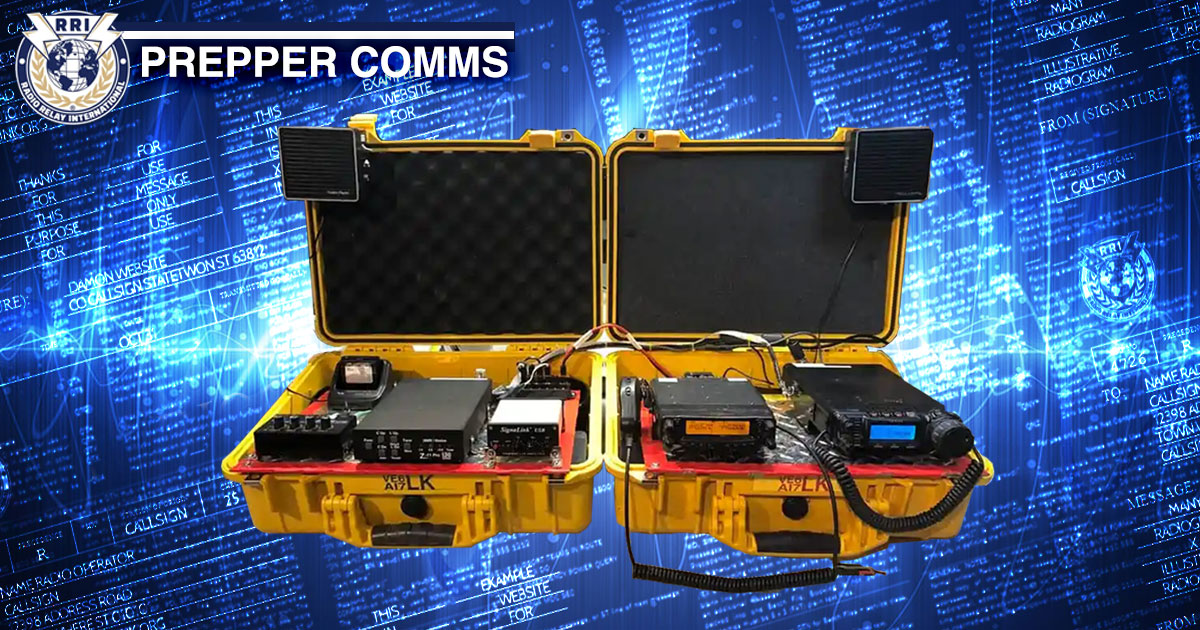Prepper Comms: Connectivity versus Communications
It appears an entire cottage industry has emerged in which various vendors sell ham radio, GMRS, and similar resources as a preparedness tool. Search YouTube using terms such as “prepper” and “communications” and one will find hundreds, if not thousands of videos that promote various communications solutions, many of which focus on ham radio. Unfortunately, one can argue that many of these videos and sales pitches amount to the proverbial “blind leading the blind.”
There is much to be said for establishing communications alternatives that support neighborhood and community preparedness. Prepper groups are fond of the term “MAG,” which translates to mutual assistance group. Having a “MAG” composed of like minded and equally dedicated and prepared people can be a very good thing, particularly if the participants are all level-headed and equally dedicated to preparedness. We won’t digress further into that subject except to assert that developing the ability to communicate in the event of disruptions to the cellular grid and local/regional Internet connectivity is a prudent preparedness step. Therefore, let’s examine the realistic communications requirements for one’s preparedness program.
Most communications are local:
This assertion should not come as a surprise. It’s been proven through 175 years of telecommunications history. The volume of communications traffic on local networks is typically higher than that on long-haul circuits. It’s simply a reflection of the nature of social hierarchy. In a SHTF situation, circumstances usually dictate that local issues are addressed first. For example, if summoning assistance, the person from whom you request assistance must be close enough to provide the needed aid. As a result, most members of one’s prepper “tribe” do not need to be ham radio operators. Common resources such as FRS/GMRS (interoperable), CB radio, or MURS are often more than adequate for covering local terrain. Even hard-wire resources such as field phones can be pressed into service between closely located homes or facilities.
The gateway process as force multiplier:
If a MAG establishes a local communications network using commonly available, inexpensive technology, messages leaving the local network can be transferred to national/international infrastructure by “gateway” operators with long-haul capabilities. One to three operators (for redundancy) in a group that have the necessary license, training, and equipment to communicate over longer distances can move message traffic between the local network and long-haul infrastructure services. For example, if someone in your prepper group needs to send a message to a relative 1000 miles away, he simply formats a radiogram, transmits it to the gateway operator, and the latter individual injects it into the long-haul network.
The gateway function is a simple force multiplier process, which allows everyone in a group to send and receive medium/long-haul messages even if they do not have an interest in communications systems as a technological hobby or avocation. The process is also not economically regressive. After all, there’s a big difference between the cost of a new or used CB or GMRS radio and a modern ham radio transceiver and associated equipment.
Gateway requirements:
While impressive and elegant, HF radio and similar resources, with their ability to communicate over long distances, are of little value if communications with distant points are established randomly. In other words, even with survivable HF radio capabilities, some type of standardized infrastructure designed to efficiently relay and route messages to their destination is required. For this purpose, one might use Winlink (radio email), the RRI Digital Traffic Network, or manual mode traffic networks using CW, SSB, or various narrowband digital methods. Each method will offer both advantages and disadvantages depending on circumstances and operational requirements. These pros and cons are outside the scope of this article but suffice to say that the ability to exchange signal reports with random stations around the country is NOT the same as rapidly and accurately transmitting record message traffic to a third party 200 or 2000 miles away. For that, one needs not only infrastructure, but one also needs training, which brings us to our final point……
Connectivity is NOT the same as communications:
The prepper community, and even some Amateur Radio emergency communications volunteers, tend to perceive disaster communications in a “break glass in time of emergency” fashion. Using a bit of imagery, the “ham radio” is an object similar to a fire extinguisher in a public space. The “ham radio” (noun) sits in a red box labeled “break glass in case of emergency.” In the mental fantasy of the prepper, he will simply break the glass, turn on the radio, and start communicating. Unfortunately, “reality bites.” One can guarantee that 100-percent of the time, prepper communications will suffer in myriad ways. Messages will arrive garbled, content will be missing, assumptions regarding content will be made, and fatal errors in messages, tactical or record message, will hamper organizational response. In other words:
THE ABILITY TO ESTABLISH CONNECTIVITY IS NOT THE SAME AS THE ABILITY TO COMMUNICATE!
Building skills and community:
Everyone expected to participate in a local prepper network must be familiar with basic radiotelephone (voice) communications procedures. The ability to use prowords (“procedural words”) correctly, the ability to use the ITU phonetic alphabet to spell and decode complex words, the ability to keep a simple radio log of tactical communications, and the ability to transcribe a message accurately and completely in writing on a message form are NOT options. They are essential skills, which can only be developed through practice, and without these skills, ANY radio network will quickly slow down to a fatal level of inefficiency.
Local network participants must practice formatting, transmitting, receiving, and transcribing simple radiogram messages. The level of practice must be frequent enough to ensure that basic communications skills are automatic under stress. Remember; if one is prepping, it stands to reason that one is preparing for a serious, if not catastrophic event. Buying a Baofeng hand-held radio or chatting on a radio channel does not make one a communicator.
In addition to providing training, organized radio networks build community. Participants get to know each other. Trust is established. Knowledge of participant reliability and skill level is gained. This is essential information in time of emergency.
The same rules apply to long-haul operation. Not only does one need infrastructure, but he must also be able to effectively navigate that infrastructure. A failure to use long-haul infrastructure regularly by participating in nets using several different methods of communications (for redundancy) will create two fatal problems, one of which affects the originator of the message, and the other of which affects the entire network operation. The presence of unskilled, unpracticed individuals on radio networks is the same as dropping the proverbial sand into the well-oiled machine. Just a few “Baofeng experts” can quickly bring a busy radio network to a grinding halt. The result is that everyone using the infrastructure service, such as a traffic network, pays a serious penalty.
There is no replacement for RRI networks:
If you’re serious about prepper communications, there is no substitute for participating in properly structured, professional-grade traffic nets. This means regularly originating, transmitting and receiving radiogram and radiogram-ICS213 messages. It means establishing a reliable connection to the network under a wide range of RF propagation conditions. It means developing the ability to keep a complete radio log. It means keeping a reference file of message traffic transmitted and received.
Lastly, while we encourage participation in RRI networks, we also encourage diversification. Practice using Winlink. Run drills and exercises in which record message traffic is transmitted on one’s local network. Use radio networks regularly under routine conditions or for day-to-day activities so the process of communications will be automatic and natural when the SHTF.
Never forget that the act of buying a “ham radio” is not the same as engaging in the ART of ham radio. Develop the needed skills, share them with your team, and ensure that everyone involved can communicate efficiently. Don’t let some self-appointed “expert” on social media convince you that owning equipment is the key to communications preparedness. Without knowledge and skills, the radio equipment will prove just about as valuable as a brick.

